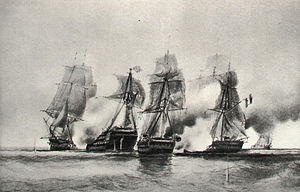
| |
| History | |
|---|---|
| Name | HMS Diomede |
| Ordered | 14 August 1779 |
| Builder | James Martin Hillhouse, Bristol |
| Laid down | March 1780 |
| Launched | 18 October 1781 |
| Completed | 14 March 1782 |
| Fate | Struck a rock on 2 August 1795 and sank almost immediately |
| General characteristics | |
| Class and type | 44-gun Roebuck-class two-decker fifth rate |
| Tons burthen | 887 37⁄94 (bm) |
| Length |
|
| Beam | 38 ft 2+1⁄2 in (11.6 m) |
| Depth of hold | 16 ft 4 in (5.0 m) |
| Sail plan | Full-rigged ship |
| Complement | 300 |
| Armament |
|
HMS Diomede was a 44-gun fifth rate built by James Martin Hillhouse and launched at Bristol on 18 October 1781. She belonged to the Roebuck class of vessels specially built during the American Revolutionary War for service in the shallow American coastal waters. As a two-decker, she had two complete batteries of guns, one on the upper deck and the other on the lower deck.
Diomede participated in two major actions. The first occurred in 1782 when she captured South Carolina of the South Carolina Navy. The second, the Battle of Île Ronde, took place in 1794 in the Indian Ocean. Although the action in the Indian Ocean was inconclusive and the French broke off contact after suffering much heavier casualties than the British, the French did succeed in breaking the blockade of Île de France and saved it from starvation.[1]
Diomede was wrecked in 1795 off Trincomalee, Ceylon, during the campaign to capture Trincomalé.
- ^ Parkinson (1954), p. 76.
